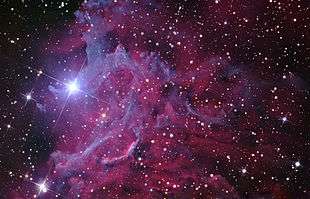AE Aurigae
| Observation data Epoch J2000 Equinox J2000 | |
|---|---|
| Constellation | Auriga |
| Right ascension | 05h 16m 18.15000s[1] |
| Declination | +34° 18′ 44.3455″[1] |
| Apparent magnitude (V) | 5.96[2] (5.78 - 6.08[3]) |
| Characteristics | |
| Spectral type | O9.5V[4] |
| U−B color index | −0.70[2] |
| B−V color index | +0.22[2] |
| Variable type | Orion variable[3] |
| Astrometry | |
| Radial velocity (Rv) | 56.70[5] km/s |
| Proper motion (μ) | RA: -3.58[1] mas/yr Dec.: 43.73[1] mas/yr |
| Parallax (π) | 2.24 ± 0.74[1] mas |
| Distance | 534[6] pc |
| Absolute magnitude (MV) | −3.92[7] |
| Details[7] | |
| Mass | 23 M☉ |
| Radius | 7.47 R☉ |
| Luminosity | 59,000 L☉ |
| Surface gravity (log g) | 4.0 cgs |
| Temperature | 33,000 K |
| Rotational velocity (v sin i) | 25[8] km/s |
| Other designations | |
GC 6429, IDS 05097+3412, GCRV 3123, IRAS 05130+3415, TYC 2398-894-1, ADS 3843, UBV M 10749, AG+34°542, GOS G172.08-02.26 01, uvby98 100034078 ABV, GSC 02398-00894, VDB 34, BD+34°980, HD 34078, PLX 1190, CCDM J05163+3419, PPM Star Catalogue 70112, AAVSO 0509+34, HIP 24575, ROT 748, WDS J05163+3419, CGO 80, SAO 57816, CSI+34 980 1, HR 1712 | |
| Database references | |
| SIMBAD | data |
AE Aurigae (abbreviated as AE Aur) is a runaway star in the constellation Auriga; it lights the Flaming Star Nebula.
Description

AE Aurigae is a blue O-type main sequence dwarf with a mean apparent magnitude of +6.0. It is classified as an Orion type variable star and its brightness varies irregularly between magnitudes +5.78 and +6.08. It is approximately 1,700 light-years from Earth.
AE Aur is a runaway star that might have been ejected during a collision of two binary star groups. This collision, which also is credited with ejecting Mu Columbae and possibly 53 Arietis, has been traced to the Trapezium cluster in the Orion Nebula two million years ago. The binary Iota Orionis may have been the other half of this collision.[9]
AE Aur is seen to light up the Flaming Star nebula, but it was not formed within it. Instead it is passing through the nebula at high speed and producing a violent bow shock and high energy electromagnetic radiation.[10][11]
Companions
AE Aurigae has a 9th magnitude companion, component B, 9" away.[12]
There is also a more distant companion HD 34042, sometimes called component C, which has a spectral type of A5.[12]
References
- 1 2 3 4 5 Van Leeuwen, F. (2007). "Validation of the new Hipparcos reduction". Astronomy and Astrophysics. 474 (2): 653. arXiv:0708.1752. Bibcode:2007A&A...474..653V. doi:10.1051/0004-6361:20078357.
- 1 2 3 Ducati, J. R. (2002). "VizieR Online Data Catalog: Catalogue of Stellar Photometry in Johnson's 11-color system". CDS/ADC Collection of Electronic Catalogues. 2237. Bibcode:2002yCat.2237....0D.
- 1 2 Samus, N. N.; Durlevich, O. V.; et al. (2009). "VizieR Online Data Catalog: General Catalogue of Variable Stars (Samus+ 2007-2013)". VizieR On-line Data Catalog: B/gcvs. Originally published in: 2009yCat....102025S. 1. Bibcode:2009yCat....102025S.
- ↑ Sota, A.; Maíz Apellániz, J.; Walborn, N. R.; Alfaro, E. J.; Barbá, R. H.; Morrell, N. I.; Gamen, R. C.; Arias, J. I. (2011). "The Galactic O-Star Spectroscopic Survey. I. Classification System and Bright Northern Stars in the Blue-violet at R ~ 2500". The Astrophysical Journal Supplement. 193 (2): 24. arXiv:1101.4002. Bibcode:2011ApJS..193...24S. doi:10.1088/0067-0049/193/2/24.
- ↑ Kharchenko, N. V.; Scholz, R.-D.; Piskunov, A. E.; Röser, S.; Schilbach, E. (2007). "Astrophysical supplements to the ASCC-2.5: Ia. Radial velocities of ˜55000 stars and mean radial velocities of 516 Galactic open clusters and associations". Astronomische Nachrichten. 328 (9): 889. arXiv:0705.0878. Bibcode:2007AN....328..889K. doi:10.1002/asna.200710776.
- ↑ Meurs, E. J. A.; Fennell, G.; Norci, L. (2005). "X-Ray Counterparts of Runaway Stars". The Astrophysical Journal. 624: 307. Bibcode:2005ApJ...624..307M. doi:10.1086/428874.
- 1 2 Martins, F.; Schaerer, D.; Hillier, D. J.; Meynadier, F.; Heydari-Malayeri, M.; Walborn, N. R. (2005). "On stars with weak winds: The Galactic case". Astronomy and Astrophysics. 441 (2): 735. arXiv:astro-ph/0507278. Bibcode:2005A&A...441..735M. doi:10.1051/0004-6361:20052927.
- ↑ Martins, F.; Hervé, A.; Bouret, J.-C.; Marcolino, W.; Wade, G. A.; Neiner, C.; Alecian, E.; Grunhut, J.; Petit, V. (2015). "The MiMeS survey of magnetism in massive stars: CNO surface abundances of Galactic O stars". Astronomy & Astrophysics. 575: A34. arXiv:1411.4420. Bibcode:2015A&A...575A..34M. doi:10.1051/0004-6361/201425173.
- ↑ Hoogerwerf, R.; De Bruijne, J. H. J.; De Zeeuw, P. T. (2001). "On the origin of the O and B-type stars with high velocities. II. Runaway stars and pulsars ejected from the nearby young stellar groups". Astronomy and Astrophysics. 365 (2): 49. arXiv:astro-ph/0010057. Bibcode:2001A&A...365...49H. doi:10.1051/0004-6361:20000014.
- ↑ López-Santiago, J.; Miceli, M.; Del Valle, M. V.; Romero, G. E.; Bonito, R.; Albacete-Colombo, J. F.; Pereira, V.; De Castro, E.; Damiani, F. (2012). "AE Aurigae: First Detection of Non-thermal X-Ray Emission from a Bow Shock Produced by a Runaway Star". The Astrophysical Journal Letters. 757: L6. arXiv:1208.6511. Bibcode:2012ApJ...757L...6L. doi:10.1088/2041-8205/757/1/L6.
- ↑ France, Kevin; McCandliss, Stephan R.; Lupu, Roxana E. (2007). "A Cometary Bow Shock and Mid-Infrared Emission Variations Revealed in Spitzer Observations of HD 34078 and IC 405". The Astrophysical Journal. 655 (2): 920. arXiv:astro-ph/0610953. Bibcode:2007ApJ...655..920F. doi:10.1086/510481.
- 1 2 Mason, Brian D; Wycoff, Gary L; Hartkopf, William I; Douglass, Geoffrey G; Worley, Charles E (2001). "The 2001 US Naval Observatory Double Star CD-ROM. I. The Washington Double Star Catalog". The Astronomical Journal. 122 (6): 3466. Bibcode:2001AJ....122.3466M. doi:10.1086/323920.
External links
- AE Aurigae Jim Kaler
- AE Aur VizieR GCVS entry
- HR 1712 VizieR Bright star catalogue entry
- AE Aurigae Aladin image
- CCDM J05163+3419 VizieR Catalog of Components of Double and Multiple Stars entry
